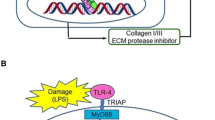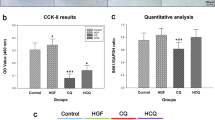Abstract
Hepatocellular carcinoma (HCC) is a malignant tumor with extremely high mortality. The tumor microenvironment is the “soil” of its occurrence and development, and the inflammatory microenvironment is an important part of the “soil”. Bile acid is closely related to the occurrence of HCC. Bile acid metabolism disorder is not only directly involved in the occurrence and development of HCC but also affects the inflammatory microenvironment of HCC. Yinchenhao decoction, a traditional Chinese medicine formula, can regulate bile acid metabolism and may affect the inflammatory microenvironment of HCC. To determine the effect of Yinchenhao decoction on bile acid metabolism in mice with HCC and to explore the possible mechanism by which Yinchenhao decoction improves the inflammatory microenvironment of HCC by regulating bile acid metabolism, we established mice model of orthotopic transplantation of hepatocellular carcinoma. These mice were treated with three doses of Yinchenhao decoction, then liver samples were collected and tested. Yinchenhao decoction can regulate the disorder of bile acid metabolism in liver cancer mice. Besides, it can improve inflammatory reactions, reduce hepatocyte degeneration and necrosis, and even reduce liver weight and the liver index. Taurochenodeoxycholic acid, hyodeoxycholic acid, and taurohyodeoxycholic acid are important molecules in the regulation of the liver inflammatory microenvironment, laying a foundation for the regulation of the liver tumor inflammatory microenvironment based on bile acids. Yinchenhao decoction may improve the inflammatory microenvironment of mice with HCC by ameliorating hepatic bile acid metabolism.
Graphical abstract






Similar content being viewed by others
Abbreviations
- ALT:
-
Alanine aminotransferase
- AFP:
-
Alpha-fetoprotein
- AST:
-
Aspartate transaminase
- HCC:
-
Hepatocellular carcinoma
- HDG:
-
Yinchenhao Decoction high-dose group
- IL-6:
-
Interleukin-6
- LDG:
-
Yinchenhao Decoction low-dose group
- LPS:
-
Lipopolysaccharide
- MDG:
-
Yinchenhao Decoction middle-dose group
- MG:
-
The model group
- SOG:
-
The sham operation group
- TCM:
-
Traditional Chinese Medicine
- TNF-α:
-
Tumor necrosis factor-α
- TNF-β:
-
Tumor necrosis factor-β
References
Sung H, Ferlay J, Siegel RL, Laversanne M, Soerjomataram I, Jemal A, Bray F (2021) Global cancer statistics 2020: GLOBOCAN Estimates of incidence and mortality worldwide for 36 cancers in 185 countries. CA Cancer J Clin 71(3):209–249
Denk D, Greten FR (2022) Inflammation: the incubator of the tumor microenvironment. Trends Cancer. https://doi.org/10.1016/j.trecan.2022.07.002
Bissell MJ, Hines WC (2011) Why don’t we get more cancer? A proposed role of the microenvironment in restraining cancer progression. Nat Med 17(3):320–329
Yang F, Huang X, Yi T, Yen Y, Moore D, Huang W (2007) Spontaneous development of liver tumors in the absence of the bile acid receptor farnesoid X receptor. Can Res 67(3):863–867
Watanabe A, Sohail MA, Gomes DA, Hashmi A, Nagata J, Sutterwala FS, Mahmood S, Jhandier MN, Shi Y, Flavell RA, Mehal WZ (2009) Inflammasome-mediated regulation of hepatic stellate cells. Am J Physiol Gastrointest Liver Physiol 296(6):G1248-1257
Allen K, Jaeschke H, Copple BL (2011) Bile acids induce inflammatory genes in hepatocytes: a novel mechanism of inflammation during obstructive cholestasis. Am J Pathol 178(1):175–186
Horvath S, Erhart W, Brosch M, Ammerpohl O, von Schönfels W, Ahrens M, Heits N, Bell JT, Tsai PC, Spector TD, Deloukas P, Siebert R, Sipos B, Becker T, Röcken C, Schafmayer C, Hampe J (2014) Obesity accelerates epigenetic aging of human liver. Proc Natl Acad Sci U S A 111(43):15538–15543
Coppé JP, Patil CK, Rodier F, Sun Y, Muñoz DP, Goldstein J, Nelson PS, Desprez PY, Campisi J (2008) Senescence-associated secretory phenotypes reveal cell-nonautonomous functions of oncogenic RAS and the p53 tumor suppressor. PLoS Biol 6(12):2853–2868
Li H (2020) Advances in anti hepatic fibrotic therapy with Traditional Chinese Medicine herbal formula. J Ethnopharmacol. https://doi.org/10.1016/j.jep.2019.112442
Zhou J, Li C, Wang L, Ji H, Zhu T (2015) Hepatoprotective effects of a Chinese herbal formulation, Yingchen decoction, on olaquindox-induced hepatopancreas injury in Jian carp (Cyprinus carpio var. Jian). Fish Physiol Biochem 41(1): 153–163
Yao X, Zhao CR, Yin H, Wang K, Gao JJ (2020) Synergistic antitumor activity of sorafenib and artesunate in hepatocellular carcinoma cells. Acta Pharmacol Sin 41(12):1609–1620
Pistritto G, Trisciuoglio D, Ceci C, Garufi A, D’Orazi G (2016) Apoptosis as anticancer mechanism: function and dysfunction of its modulators and targeted therapeutic strategies. Aging (Albany NY) 8(4):603–619
Cai FF, Wu R, Song YN, Xiong AZ, Chen XL, Yang MD, Yang L, Hu Y, Sun MY, Su SB (2018) Yinchenhao decoction alleviates liver fibrosis by regulating bile acid metabolism and TGF-β/Smad/ERK signalling pathway. Sci Rep. https://doi.org/10.1038/s41598-018-33669-4
Chen Z, Lin T, Liao X, Li Z, Lin R, Qi X, Chen G, Sun L, Lin L (2021) Network pharmacology based research into the effect and mechanism of Yinchenhao Decoction against Cholangiocarcinoma. Chin Med. https://doi.org/10.1186/s13020-021-00423-4
Chiang JYL, Ferrell JM (2018) Bile acid metabolism in liver pathobiology. Gene Expr 18(2):71–87
Xie G, Wang X, Huang F, Zhao A, Chen W, Yan J, Zhang Y, Lei S, Ge K, Zheng X, Liu J, Su M, Liu P, Jia W (2016) Dysregulated hepatic bile acids collaboratively promote liver carcinogenesis. Int J Cancer 139(8):1764–1775
Kusaczuk M (2019) Tauroursodeoxycholate-bile acid with chaperoning activity: molecular and cellular effects and therapeutic perspectives. Cells. https://doi.org/10.3390/cells8121471
Qi YC, Duan GZ, Mao W, Liu Q, Zhang YL, Li PF (2020) Taurochenodeoxycholic acid mediates cAMP-PKA-CREB signaling pathway. Chin J Nat Med 18(12):898–906
Zhu H, Bai Y, Wang G, Su Y, Tao Y, Wang L, Yang L, Wu H, Huang F, Shi H, Wu X (2022) Hyodeoxycholic acid inhibits lipopolysaccharide-induced microglia inflammatory responses through regulating TGR5/AKT/NF-κB signaling pathway. J Psychopharmacol 36(7):849–859
He J, Liang J, Zhu S, Zhao W, Zhang Y, Sun W (2011) Protective effect of taurohyodeoxycholic acid from Pulvis Fellis Suis on trinitrobenzene sulfonic acid induced ulcerative colitis in mice. Eur J Pharmacol 670(1):229–235
Baghdasaryan A, Fuchs CD, Österreicher CH, Lemberger UJ, Halilbasic E, Påhlman I, Graffner H, Krones E, Fickert P, Wahlström A, Ståhlman M, Paumgartner G, Marschall HU, Trauner M (2016) Inhibition of intestinal bile acid absorption improves cholestatic liver and bile duct injury in a mouse model of sclerosing cholangitis. J Hepatol 64(3):674–681
Rau M, Stieger B, Monte MJ, Schmitt J, Jahn D, Frey-Wagner I, Raselli T, Marin JJ, Müllhaupt B, Rogler G, Geier A (2016) Alterations in enterohepatic Fgf15 signaling and changes in bile acid composition depend on localization of murine intestinal inflammation. Inflamm Bowel Dis 22(10):2382–2389
Yan T, Yan N, Wang H, Yagai T, Luo Y, Takahashi S, Zhao M, Krausz KW, Wang G, Hao H, Gonzalez FJ (2021) FXR-deoxycholic acid-TNF-α axis modulates acetaminophen-induced hepatotoxicity. Toxicol Sc 181(2):273–284
Shihabudeen MS, Roy D, James J, Thirumurugan K (2015) Chenodeoxycholic acid, an endogenous FXR ligand alters adipokines and reverses insulin resistance. Mol Cell Endocrinol 414:19–28
Treeck O, Buechler C, Ortmann O (2019) Chemerin and Cancer. Int J Mol Sci. https://doi.org/10.3390/ijms20153750
Shin WJ, Pachynski RK (2018) Chemerin modulation of tumor growth: potential clinical applications in cancer. Discov Med 26(141):31–37
Lin W, Chen YL, Jiang L, Chen JK (2011) Reduced expression of chemerin is associated with a poor prognosis and a lowed infiltration of both dendritic cells and natural killer cells in human hepatocellular carcinoma. Clin Lab 57(11–12):879–885
Li JJ, Yin HK, Guan DX, Zhao JS, Feng YX, Deng YZ, Wang X, Li N, Wang XF, Cheng SQ, Bao Y, Xie D (2018) Chemerin suppresses hepatocellular carcinoma metastasis through CMKLR1-PTEN-Akt axis. Br J Cancer 118(10):1337–1348
Acknowledgements
We would like to express our gratitude to Biotree for generously providing the complimentary online platform (https://www.biotree.cn/) for the analysis of UHPLC–MS-MS data.
Funding
The study was supported by the National Natural Science Foundation of China (No. 81904119) and the key Clinical Specialty Discipline Construction Program of Fujian, P.R.C. The study was also supported by the program of the sixth batch of reserve talents of traditional Chinese medicine in Xiamen, Fujian.
Author information
Authors and Affiliations
Contributions
JS: performed research, provided, and analyzed the data, and wrote the draft paper. LZ: performed research, provided, and analyzed the data, and wrote the draft paper. JS and LZ have contributed equally to this work and share first authorship. BYT: performed experiments, Formal analysis, and edited the manuscript. WQY: performed experiments, Formal analysis, and edited the manuscript. SYX: performed experiments, Formal analysis, and edited the manuscript. CLZ: performed experiments, Formal analysis, and edited the manuscript. PFL: performed experiments, formal analysis, analyzed the data, and edited the manuscript. KHG: performed experiments, formal analysis, and edited the manuscript. JRH: performed experiments, formal analysis, and edited the manuscript. CRH: performed experiments, formal analysis, and edited the manuscript. ZXY: performed experiments, formal analysis, and edited the manuscript. BKY: performed experiments, Formal analysis, and edited the manuscript. CFZ: Methodology, designed, organized, supervised research, and identified traditional Chinese medicines. YMZ: Methodology, designed, organized, and supervised research and edited the paper. All authors contributed to the paper and approved the submitted version.
Corresponding authors
Ethics declarations
Conflict of interest
All authors certify that they have no affiliations with or involvement in any organization or entity with any financial interest or non-financial interest in the subject matter or materials discussed in this manuscript.
Additional information
Publisher's Note
Springer Nature remains neutral with regard to jurisdictional claims in published maps and institutional affiliations.
Supplementary Information
Below is the link to the electronic supplementary material.
Rights and permissions
Springer Nature or its licensor (e.g. a society or other partner) holds exclusive rights to this article under a publishing agreement with the author(s) or other rightsholder(s); author self-archiving of the accepted manuscript version of this article is solely governed by the terms of such publishing agreement and applicable law.
About this article
Cite this article
Shi, J., Zhu, L., Tang, BY. et al. Regulatory effect of Yinchenhao decoction on bile acid metabolism to improve the inflammatory microenvironment of hepatocellular carcinoma in mice. J Nat Med 78, 633–643 (2024). https://doi.org/10.1007/s11418-024-01812-3
Received:
Accepted:
Published:
Issue Date:
DOI: https://doi.org/10.1007/s11418-024-01812-3




